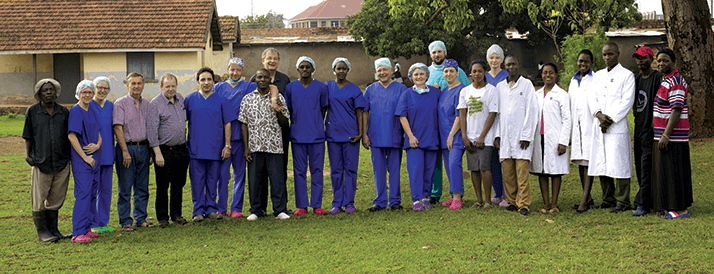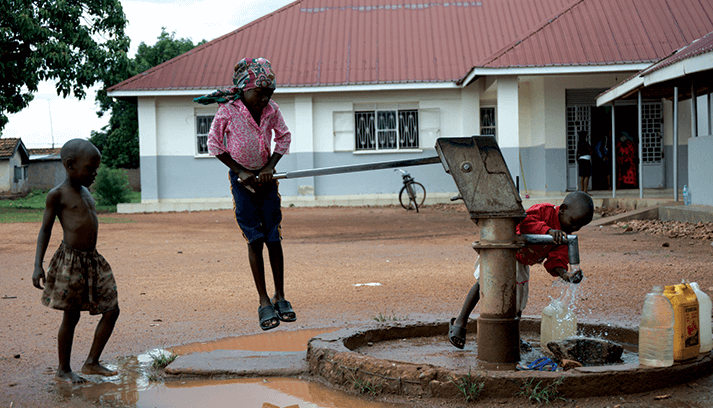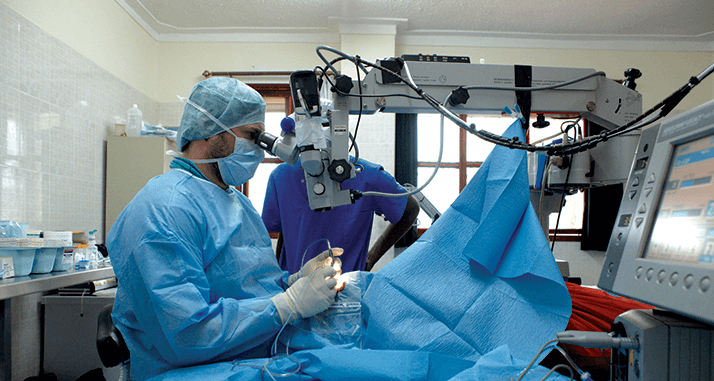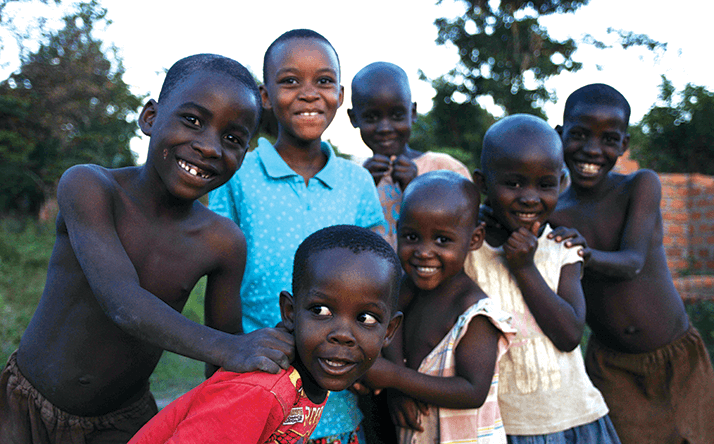
Though people’s perceptions of Uganda are often tainted by its turbulent past, the country is, in fact, one of Africa’s most peaceful, stable, and democratic countries. No longer a country to be feared, it’s widely regarded as one of the continent’s safer destinations. And with its dense, misty forests, glassy lakes and sprawling savannahs, it’s no wonder Sir Winston Churchill dubbed Uganda “the pearl of Africa.” My own journey to Uganda starts on the 18th of March 2015. It’s a crisp, clear morning as we board our flight, but by the time we disembark in Entebbe, the temperature has jumped nearly 20°C. There are six of us traveling today – me; my husband Florian Kretz, an ophthalmologist at the eye clinic in Ahaus-Raesfeld-Rheine, Germany; and four of his colleagues, Ralf Gerl, Mazen Al Saad, Abraham Mayer, and Ludwig Krabbe. We’re here in Uganda with the specialized African Medical Eye team, to provide ophthalmic care to patients who might otherwise not be able to access the treatment they need.
We arrive at a small village called Kasana, two hours’ drive northwest of Uganda’s capital, Kampala. Set against a rural backdrop of green trees and brown earth is a German eye hospital, founded and sponsored by our traveling companion Ralf Gerl in conjunction with the local government, the Ugandan Health and EyeCare Association (UHECA), and bazunga e.V., a charity association from Germany. It’s a unique collaboration between German and Ugandan nurses and doctors, working side by side to help the population of Uganda. The official language of the hospital is English, with the Ugandan nurses translating for patients who need it – and there are no barriers to treatment regardless of age, race or gender. People come from far and wide to be treated for their eye complaints, so when we arrive, we get straight to work.

One woman who received treatment at the clinic last year walked over 400 km from Rwanda for cataract surgery. This year, she made the trip again for treatment on her second eye. The people who visit this hospital come with little in the way of expectations, because neither free surgical care nor good follow-up is common in rural Uganda. The procedures used in the clinic are unusual by Ugandan standards, too; for instance, phacoemulsification is not yet the accepted procedure for cataract removal, unlike in Europe. But the techniques are effective; patients who have come to the eye hospital in the past have been amazed by their quick recoveries, especially compared with the stories they’ve heard from others who were able to afford cataract surgery in Uganda’s private hospitals. In total, the hospital has prevented an estimated 600,000 cases of cataract-caused blindness.
There’s a lot of news coming out of Africa lately, and much of it doesn’t sound good. Safe in our European homes, our newspapers and televisions show us images of villages stricken with poverty and illness – for instance, the recent Ebola outbreak across Africa. We might look at each other and ask ourselves, “Why would I want to go there to volunteer? I could catch malaria or be bitten by a deadly snake! How could I possibly stay safe on such a continent?” But although the news paints a frightening picture of Africa, we found that a little knowledge and careful preparation kept us safe and comfortable on our trip. We made sure to get all of the vaccinations required by the Centers for Disease Control and Prevention (CDC). We were diligent about taking our antimalarial medication, we drank copious amounts of bottled water to prevent dehydration, and of course, we brought enough protective sunscreen to keep us from burning under the hot African sun. My best friends in Uganda were my bug spray and mosquito netting, which let me get a good night’s sleep at the end of each day – and with those precautions, we were well prepared for our adventure.

As I observe the inner workings of the clinic, I’m amazed at the effort the team puts into organizing everything. Each patient who arrives for examination gets his or her own clinical file, and after each operation, their names and data are recorded for future visits. But there’s no health information system here – in fact, there isn’t even a computer, so every piece of information is recorded by hand. I especially notice the great care and respect with which each patient is examined, watching the nurses and physicians’ assistants translate the procedures and treatment plans for the patients. Small details like this are the reason some patients travel so far for their surgeries; not only is everyone treated for free and without restrictions, but they receive the same care and courtesy as those who are able to pay for expensive procedures in the big cities. And it shows – the looks on our patients’ faces even before their operations, when they are welcomed to the clinic and treated with love and respect, are truly heartwarming.
In the 11 working days our group spent in Uganda, we were able to perform 236 procedures. Of these, 200 were cataract surgeries (100 phacoemulsifications, 90 extracapsular cataract extractions and 10 intracapsular cataract extractions), along with 20 lid and conjunctiva surgeries and 16 surgical procedures for glaucoma. It certainly wasn’t the conditions the German ophthalmologists were accustomed to in the operating theater – surgeries took place in heat of up to 40°C each day, and with limited staff, we often had to jump in on short notice and fill multiple roles. But there was great teamwork, with everybody willing to help in any position that was needed – and that’s why we were able to accomplish as much as we did with our short time in Uganda.
The average visual acuity in a cataract patient in Uganda is not comparable to European statistics. In Germany, Florian – a cataract and refractive specialist – starts recommending cataract surgery when his patients’ visual acuity reaches 20/32. In Uganda, our patients’ average visual acuity lies somewhere between the ability to see hand movements and the ability to count the fingers on those hands, with most exhibiting mature to hypermature cataractous lenses. Still, our surgeons give their best, and many of our patients achieve results of 20/25 on the first day after surgery. It’s easy to see their feelings when the patches are taken off their eyes and they are once again able to see clearly the beauty of their own country.

How do you capture the moment in time when two cultures come together? One helping the other; one embracing the other with trust and friendship. It was such a different world in Uganda that I couldn’t help but realize – even though we came with open hands to offer help – the immeasurable amount of trust the people of Kasana had to place in foreign healthcare workers from so far away. But ultimately, whether they had spent their whole lives in Africa or arrived only a few days earlier by airplane, the doctors, surgeons, nurses, assistants, and other volunteers all worked tirelessly to give the gift of sight with love and determination. It took a lot of sweat, tears and hardship – but embracing that brought our group together and allowed us to make a difference.
As we leave the hospital on our last day, I can’t help but think of what I’m leaving behind – new friends, new foods, and new experiences. Volunteering here has been exciting – I’ve had the privilege of meeting wonderful people, participating in a meaningful project, and experiencing a new and dynamic part of the world. I know I’m going to treasure these days for the rest of my life – and I hope that in the future, we will be blessed to look into the shining eyes of our patients again, and they will use their new vision to look into our eyes and remember us “muzungu.”
Nicole M. Kretz is one of the volunteers who went to Uganda to support her husband and his team from the eye clinic in Ahaus-Raesfeld-Rheine, Germany, in providing free eye care in the village of Kasana, Uganda.

